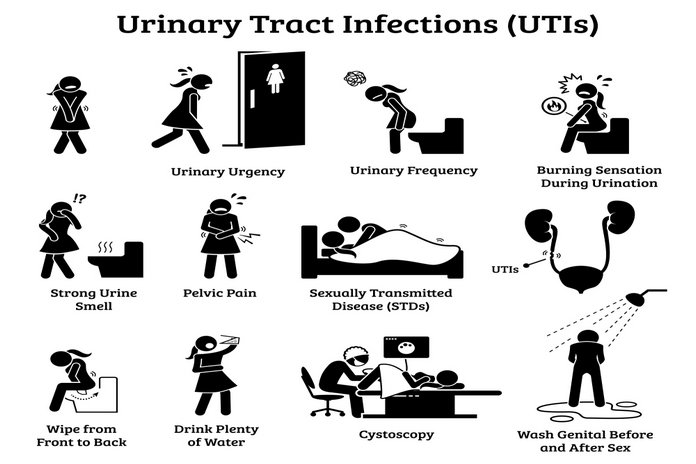UTI Risk Factors
The risk factors for UTI are different among women, men, and kids, while other things that increase the risk for UTI are common with everyone.
UTI Risk Factors Common With Everyone
Holding Your Urine: When you do not go to the restroom when you have to, or you do not empty your bladder fully, it may build up bad bacteria in your urinary tract.
Kidney Stones: Kidney stones can block your urinary tract and prevent the normal flow of urine.
Diabetes: leads to higher sugar levels in the urine and blood. Increased sugar levels in the urine promote bacterial growth.
If Recently Used a Bladder or Urinary Catheter. If you cannot pee on your own, flexible tubes are used to drain urine from your bladder into a bag. It is done after some surgeries.
UTI Risk Factors Common With Women
Being Sexually Active: Many bacterias that cause UTI, live around your anus. Any sexual activity can move these bacteria near the anus, where they can easily enter the urethra and travel towards your bladder.
Using Spermicides or a Diaphragm: These birth control processes make it easy for harmful bacteria to enter the bladder. Spermicides kill off harmless bacteria around or in the vagina, thus helping harmful bacteria to survive.
Pregnancy: Pregnancy causes several changes in the urinary tract, thus making it harder to empty your bladder fully. Pregnancy hormones can cause changes in the chemical composition of your urine that may promote bad bacterial growth.
Menopause: Menopause drops the estrogen level in the body and increases vaginal dryness that can increase the chances of getting a UTI.
Wearing Tiny Lingerie: The space between your vagina, the opening of your urethra, and your rectum are not too wide, and by wearing a teddy, a thong, or string-bikini underwear may trap bad bacteria around the vaginal area.
Wiping in a Wrong Way: Bad bacteria can be introduced in the urinary tract if you are wiping in a back to front manner after using the toilet. It would be best if you wiped in front to back manner.
UTI Risk Factors Common With Men
Enlarged Prostate: If the prostate is enlarged, a condition known as benign prostatic hyperplasia (BPH), makes it difficult to empty the bladder fully. It also blocks the passage of urine out of the bladder.
Older Age: Urinary Tract Infections are more common in men over the age of 50 years.
Unprotected Anal Sex: The bad bacteria that cause UTI may be present around the anus.
UTI Risk Factor Common With Children
Prematurity: Premature birth may make infants prone to experience UTI. Premature babies have underdeveloped immune systems, so they’re not able to fight off infections as the normal babies.
Being Uncircumcised: The risk of UTI is more in uncircumcised boys than those who have been circumcised. However, proper hygiene can minimize risk.
Poor Bathroom Hygiene: This may be a major issue, especially for those girls, who have a shorter distance for harmful bacteria to cover the area between the anus and urinary tract. They should make sure to wipe the area from front to back and to wipe away all faecal material completely.
Abnormalities of Urinary Tract: About 20 to 30 per cent of toddlers and infants with a UTI face a condition known as vesicoureteral reflux (VUR), in which the urine flows in the backward direction from the bladder to the ureters. Sometimes VUR gets better and goes away on its own. Otherwise, surgery may be needed to treat the abnormality.
Sitting in a Wet Swimming Suit: Moist and warm areas can be a breeding site for bacteria.

